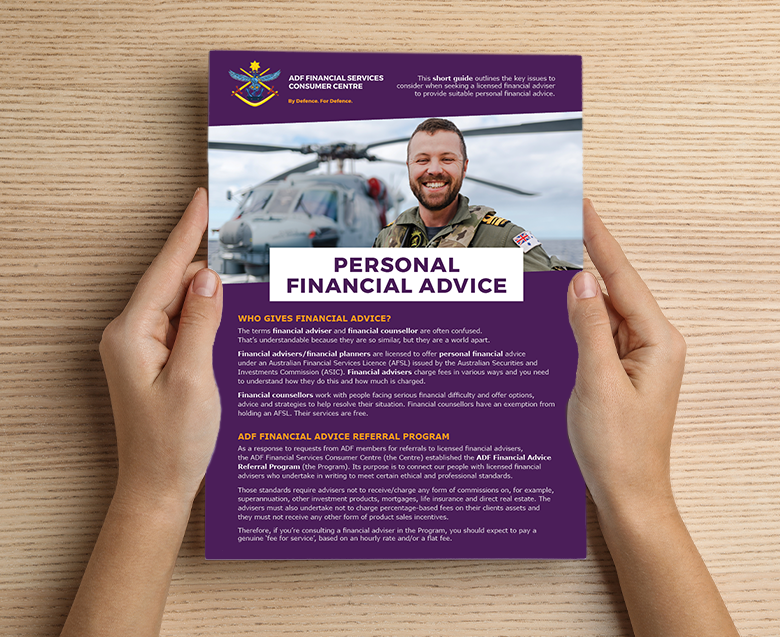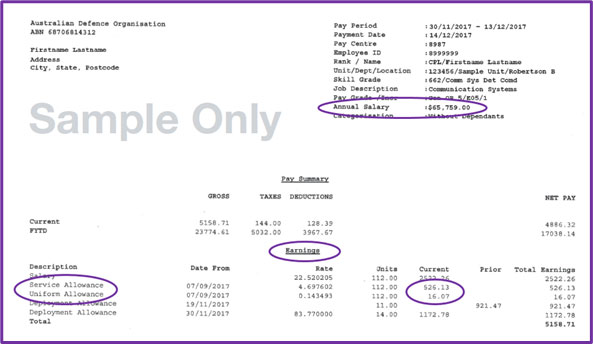TRANSITIONING OR RETIRING
Transitioning or retiring from full-time service in Defence is a time of change and some of the changes you will experience have financial implications.
We want you to have a successful transition or retirement that is as stress-free as possible, but we also want to make sure you and your family are protected.
Preparing for Transition
This page is a brief summary of the financial issues that we know members most often need to consider and address prior to their transition in order to set themselves up for success.
Thinking about transitioning from the ADF? Watch this short video to explain some of the financial aspects to consider to make your transition as smooth as possible.
Review your finances
Whether you are retiring or moving on to the next phase of your working life, when you leave the ADF your income and expenses are likely to change. To manage these changes it might be a good time to look at your budget and review your financial goals. If you don’t already have an emergency fund, a good short-term goal might be to save 3-6 months’ worth of expenses as a safety net for any unforeseen circumstances.
How much will you need in retirement?
If you are retiring, you may be wondering whether your income will be enough to sustain your lifestyle after you stop work.
Typically, when you retire, there will be changes to your spending habits. For example, work related expenses like transport, coffees, lunches, and uniform expenses may decrease, while spending on leisure activities and hobbies may increase. Think about how your income needs may change.
What do you want your retirement to look like? If you can answer that question it will be easier to work out the sort of income you’ll need to fund it. Often retirees plan to spend more in the first few years of retirement and less as they get older, perhaps something to consider when you’re planning your retirement income needs.
You may receive income from multiple sources in retirement, for example superannuation, DVA or Centrelink payments and income from investments. You’ll need to account for all income sources in your planning.
Superannuation
Super is a government mandated retirement savings vehicle. Whether you are leaving the ADF for retirement, discharging on medical grounds, being retrenched or resigning, when you transition out of the service, you’ll need to make some decisions about your super.
The benefits you may receive and what you can do with your super will depend on which fund you are a member of and why you are leaving the Service.
If you need to get professional advice on your options, consider consulting with the trustee of your superannuation fund. In the case of DFRDB, MSBS and ADF Super, the trustee is csc.gov.au. Alternatively, you could appoint a licensed financial adviser. Before doing so, we recommend that you read our Getting Financial Advice section, watch our Video Financial Advisers - The facts and the fiction and consider sourcing an adviser through our Financial Advice Referral Program.
Post ADF Super Choices
If you are moving on to civilian employment and decide to rollover eligible benefits to another complying super fund, there are broadly three types of super funds typically available to you:
- Industry super funds - not-for-profit or profits-to-members funds, typically linked to participants in specific industries
-
Retail super funds - typically owned by financial institutions.
- Self-managed super funds (SMSFs) – are where you set up and manage your own super fund. These can be costly to run as you will need to pay for accounting and auditing each year. While you can choose a variety of investments, they must still be fit for the purpose of providing you with an income in retirement. If investing is not your area of expertise, you may also need to pay for professional investment advice.
If you need help choosing a new fund, the Moneysmart website has information on choosing a super fund. Comparison websites help you see what’s available in the market so you can choose a fund to suit your needs. The Australian Tax Office's Superannuation Tool is also recommended as an independent source of information about your options.
Personal Insurance
ADF members have statutory death and invalidity cover through ADF Cover, MSBS or DFRDB, which provides benefits to you or your family if you become ill, injured or pass away. You also have comprehensive compensation and rehabilitation cover. This cover will cease when you leave the ADF.
If you wish to maintain cover after you leave the service, you will need to source personal insurance privately. It’s a good idea to have your private cover in place before your termination date. Common types of personal insurance include:
- Death cover (also known as life insurance) – pays a lump sum to your nominated beneficiaries in the event of your death.
- Total permanent disability (TPD) cover – pays you a lump sum in the event you suffer a serious illness or injury and are unlikely to work again.
- Income protection – pays you a percentage of your income if you are temporarily unable to work due to injury or illness.
If you have, or open, a civilian super fund you may have a basic level of death, TPD, and income protection insurance within super. You can usually increase the amount of cover to suit your needs, or cancel it completely if you wish to do so or have taken out cover elsewhere. Personal insurance policies are also available outside super. The Moneysmart life insurance calculator can help you calculate an appropriate amount of cover.
If you are moving on to the Reserves, be aware that most personal insurance policies outside Defence have war and war-like exclusions. Check with your insurer whether your Reserve service will exclude you from being able to claim on a policy before you pay any premiums.
For information on your current death and invalidity cover read our personal insurance guide or visit the CSC website.
The Department of Veterans’ Affairs (DVA) has rehabilitation and compensation schemes for serving and former serving ADF members. They also provide support for ADF members who are transitioning out of the service. To find out more about benefits and entitlements visit the DVA’s on base advisory service (OBAS) or go to the DVA website.
Medicare & private health insurance
As an ADF member, Defence takes care of all your medical, dental, optical and ancillary healthcare needs. When you transition out of the Service, you will be responsible for your health.
Medicare
Medicare will cover 100% of your costs if you are admitted to hospital as a public patient, some of the fees charged by GP’s and other medical professionals, and subsidised prescription costs for medicines listed on the Pharmaceutical Benefits Scheme (PBS).
You should register with Medicare before you leave the service but you won’t be able to use it until after you’ve transitioned out.
For more information, visit the Services Australia website.
Private health insurance
Private health insurance covers a range of services not covered by Medicare, for example, a private hospital and the doctor of your choice, as well as ancillary services such as dental, optical and physio.
If you are single and earn over $90,000 or a family earning more than $180,000 and you do not have private hospital cover you may have to pay an additional Medicare levy surcharge of up to 1.5%. This is in addition to the standard 2% Medicare levy.
When considering private health insurance, think about your cover needs, now and in the future. Generally, the more you are covered for, the higher the premium.
If you wait too long to take out private health insurance you’ll pay the Lifetime Health Cover Loading (LHC). This increases your premiums by an extra 2% for every year after age 30 that you haven’t had private hospital cover. There are special conditions that apply to full-time ADF members who discharge after age 30. For more information, visit the Government’s Private Health website.
Housing
Many ADF members receive subsidised housing so when you leave Defence your cost of housing is likely to increase. If you are currently in Defence housing, you will need to find alternate accommodation.
DHOAS
If you have a property, or are thinking about buying a home before you leave the service that you intend to live in, consider whether the Defence Home Ownership Assistance Scheme (DHOAS) could benefit you.
DHOAS is a scheme that helps ADF members own their own home by giving you a subsidy, paid directly into your qualifying home loan. If you have a period of full-time service greater than 4 years, you may be eligible for assistance through the scheme.
Service credit accumulated through eligible service can still be used after you leave the ADF. You have a limited window to use your DHOAS entitlement after you separate from Defence and you may benefit from obtaining a subsidy certificate before you leave.
There are a limited number of approved lenders who participate in the scheme so it’s recommended you compare what DHOAS may offer you with the cost of obtaining a loan from other lenders. You can find more information on the DHOAS website.
First home buyers
If you are looking to buy your first home, you may be eligible for the First Home Owner’s Grant (FHOG) and/or other incentives available to first home buyers. The FHOG is a national scheme, administered and funded by each state and territory, which provides a one-off grant to eligible first home owners. Some states and territories also offer stamp duty concessions to first home buyers.
From time to time the federal government offers additional incentives to fist home buyers to buy or build a new home, so search out what is available to you to make the most of your new home purchase.
For additional information on purchasing a property, visit our Buying a home savings guide.
Managing debt
Australian personal debt levels are among the highest in the world. Not all debt is bad, for example, most of us could not buy a home without taking on some debt, but too much of it can put a strain on your finances and create stress in other areas of your life.
Financial institutions sell debt, it’s how they make their money. Think carefully about the level of debt you are comfortable with so that you don’t get in over your head.
Borrowing for business
If you are borrowing for a business venture, ask yourself, can I repay this if the business doesn’t generate the income I think it will? Consider having a fall-back position of 6–12 months’ worth of expenses in a high-interest saving account you can access in an emergency, or if the business takes time to generate a profit. The more uncertain you are of generating an income, the larger your fall-back position should be.
If you’re thinking about starting a business, watch our video Starting, Operating and Selling a Business – The SOS Principles.
Controlling high-interest debt
If you are paying off any high interest debt, such as a credit card or personal loan try to make getting it paid down a priority. If you have more than one high–interest debt:
- Choose the one with the highest interest rate and make additional repayments until it is paid off.
- Then allocate additional repayments to the debt with the second highest interest rate, and so on until all debts have been repaid.
If you are struggling to repay debt or your circumstances are more complex, read our debt section or contact us so that we can put you in touch with a free financial counsellor to help you get back on track.
Mortgages
When borrowing money to buy a property, a comparison website will give you a good idea of the home loan rates available in the market. Look for the best rates you can find, on loans with the features you want. Use the information to negotiate a better rate with your current bank, or start fresh with a new lender.
Features such as a redraw facility or offset account, allow you to net your savings off with your loan, reducing the amount of interest you pay. It’s a bit like earning a mortgage interest rate on your savings. Always look for a loan you can pay off early without penalty.
Wills and Power Of Attorney
Will
A Will is a legal document that dictates how your assets should be distributed when you die. If you die without a valid Will you will be said to have died intestate and your assets will be distributed according to intestacy laws in your state, which may not be in line with your wishes.
For a Will to be valid it must meet certain criteria, which is why we recommend seeing a lawyer, legal officers from Defence Counsel Services can also help.
Store a copy of your Will in a safe place and tell your executor and next of kin where it is. If you are concerned about how your beneficiaries will manage their inheritance, ask your lawyer about a testamentary trust.
Review your Will whenever your personal circumstances change, for example, you get married, separated or divorced, or become a parent, and make arrangements to update it if necessary. If you need to update your Will, consider doing this before you leave Defence, as permanent ADF members can usually have a simple Will written or updated for free. Contact Defence Counsel Services.
Telephone: 1800 563 563
Email: [email protected]
Power of attorney
While a will is something that all adults should have, a Power of Attorney (POA) is something that you might want to think twice about.
When you grant someone a POA, you are giving them the power to manage your money on your behalf. That means they can operate your bank accounts, buy or dispose of assets, and make financial decisions as if they were you.
You can limit a POA, for example, you could make it valid only for a specific period of time, or only allow transactions up to a certain dollar amount.
There are different types of POA, for example:
- General – ceases if you lose mental capacity
- Enduring – continues to operate after you have lost mental capacity
- Medical – allows your appointee to make decisions about your medical treatment if you become mentally or physically incapable of deciding for yourself.
Only grant a POA to someone you completely trust and get appropriate legal advice first.
Professional Advice
Before choosing a professional adviser, make sure they have the qualifications and experience to give the kind of advice you are after. Make sure you understand and agree the scope of the job and the fees before proceeding, these should be outlined in an Engagement Letter.
Financial advice
If you are thinking about getting financial advice, read our Getting financial advice section, and watch our video Financial advisers: the facts & the fiction, which will give you an idea of what to expect when you see a financial adviser.
Our financial advice referral program is a good place to start if you are looking for a fee-for-service financial adviser. Be aware that we do not recommend or endorse the advisers on the list and any relationship between you and the adviser is a strictly private relationship.
Tax advice
For help with a simple tax return, a registered tax agent may be all you need. You can find a registered tax agent in your area by using the search function on the Tax Practitioners Board website.
If your financial affairs are more complex, you may be better off speaking to a qualified accountant that has completed additional professional training. You can find a list of appropriately qualified accountants on the websites of industry associations such as Chartered Accountants of Australia and New Zealand or CPA Australia.
Legal advice
Your first point of call for legal issues should be Defence Counsel Services, which provides independent, free legal support to ADF members. They can arrange legal assistance for ADF members dealing with:
- trial before a court martial or Defence Force magistrate
- notice to show cause for administrative action
- redress of grievance
- medical employment category review board proceedings
- compensation for detriment caused by defective administration
- preparing a will
- civilian legal matters such as family law (limited to preliminary information)
You can contact Defence Counsel Services by:
Phone: 1800 563 563 or 02 6266 1190 (overseas only)
Email (legal assistance): [email protected]
Email (wills): [email protected]
Transition Briefing
Missed the finance session at the transition seminar? Or want to revisit the financial concepts we covered? Our presentation, Your Money and You has been recorded as a video presentation you can watch to gain an understanding of the financial aspects of transition; some of the key things to consider and decisions you’ll need to make.

Financial Advice
If you are thinking about getting financial advice, we recommend you read our Getting financial advice section, download our Personal Financial Advice Guide and watch our video Financial Advisers: The Facts & The Fiction, which will give you an idea of what to expect when you see a financial adviser.
Our Financial Advice Referral Program is a good place to start if you are looking for a fee-for-service financial adviser. Be aware that we do not recommend or endorse the advisers on the list and any relationship between you and the adviser is a strictly private relationship.

